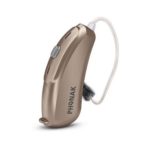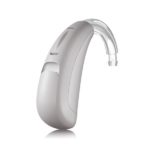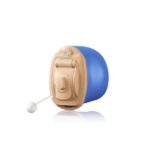HEARING AID BY STYLE
The right hearing solution is unique to your lifestyle, preferences, and needs.
Explore each style below

Receiver-In-Canal (RIC)
RICs are worn behind the ear and have a wire bringing the sound to a speaker which sits inside the ear canal. RICs tend to be smaller and more cosmetically appealing than a standard behind the ear (BTE) hearing aid.
Among all the styles of hearing aids, the receiver-in-canal type is something of a hybrid. It looks like a standard Behind-the-ear (BTE) aid, but its components are divided into two parts: the case, which fits behind the ear holding the amplifier and microphone and a small earpiece holding the receiver, which fits inside the ear. A tiny, virtually invisible electrical wire connects the parts.
Read More
RIC hearing aids are very unobtrusive, with a case that’s among the least visible. The receiver is placed in a small silicone dome that fits into the ear canal. Many users find the small bud that fits into the ear canal comfortable with a less plugged-up feeling. Receiver-in-canal aids have superior sound quality, Bluetooth capabilities, a more natural sound, and less feedback. They’re particularly good at amplifying high frequency sound. Additionally, it is easier to switch to a higher power speaker if hearing loss changes, preventing the need for an entirely new hearing aid purchase. RICs can have some drawbacks, including being susceptible to moisture in the ear canal and earwax clogging, which may mean more frequent maintenance and care. But overall, for people with mild to severe hearing loss, the RIC style of hearing aid is a good choice, both cosmetically and for sound quality.

Behind-The-Ear (BTE)

In-The-Ear (ITE)
Read More
Some hearing aid manufacturers have even developed smaller version of CICs called custom invisible-in-canal (IIC). CICs and IICs sit completely in the ear canal, making them virtually invisible. The custom CIC and IIC hearing aids usually give up certain features and components and will have a shorter battery life because of the small battery size needed to fit completely into the ear canal. Many CICs give up the wireless capability available in the RIC, BTE and larger custom hearing aids in order to be made so cosmetically small and appealing.
